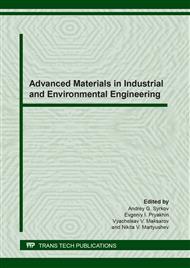[1]
V.L. Trushko, V.A. Utkov, V.Yu. Bazhin, The relevance and the possibility of full processing of red slimes of aluminous production, Notes of the Mining Institute 227 (2017) 547-553 (in Russian).
Google Scholar
[2]
I.N. Pyagay, Extraction of Scandium and Other Metals from Red Mud of Alumina Production with Absorption of Toxic Gases of Sintering Kilns, candidate dissertation, St. Petersburg, 2017, pp.7-8; 76-82.
Google Scholar
[3]
B.P. Kulikov, L. A. Vertoprakhova, M. N. Pigarev, Utilization of wastes from red mud fields at aluminum plants in cement production, Non-Ferrous Metals 3 (2006) 46–51 (in Russian).
Google Scholar
[4]
E.I. Pryakhin, N.I. Sharonov, Basic provisions and problems of ELW technology for the manufacture of aluminum-magnesium alloys constructions, Notes of the Mining Institute 229 (2018) 84–91 (in Russian).
Google Scholar
[5]
E. N. Ogorodnikova, S. K. Nikolaeva, Red mud: the issue of storage and utilization, Engineering and geological problems of our time and methods of their solution: Materials of the scientific and practical conference, Moscow, 2017, p.284–288. (in Russian).
Google Scholar
[6]
V.A. Utkov, Theory and practice of red mud processing, Technique and Technology 3 (2012) 56–57. (in Russian).
Google Scholar
[7]
V.A. Utkov, V.M. Sizyakov, Modern issues of metallurgical processing of red sludge, Notes of the Mining Institute 202 (2013) 39-43. (in Russian).
Google Scholar
[8]
K. Zh. Zhumashev, The study of methods of processing red mud and assessment of the possibility of developing a new direction of research, Innovations in Materials Science and Metallurgy: Proceedings of the IV International Interactive Scientific and Practical Conference, Yekaterinburg, 2015, pp.122-126. (in Russian).
Google Scholar
[9]
A.B. Lebedev, The use of red mud as a modifier in the granulation of metallurgical slags, Irkutsk State Technical University Bulletin 23(1) (2019) 158-168. (in Russian).
DOI: 10.21285/1814-3520-2019-1-158-168
Google Scholar
[10]
A.V. Demin, V.T. Sorokin, V.Yu. Piiraynen, Application of new materials for radioactive wastes immobilization, International Nuclear Forum: X Anniversary International Conference Safety of Nuclear Technologies,, St. Petersburg, (2007).
Google Scholar
[11]
Yu. P. Solntsev, V. Yu. Piiraynen, S. A. Vologzhanina, Material Science of Special Branches of Machine-Building, St. Petersburg, Chimizdat, (2007).
Google Scholar
[12]
A.A. Boeva, V. Yu, Piiraynen, Red mud immobilization and production of construction materials from it, International Seminar Round Table of Young Scientists. Innovations and Prospects for the Development of Mining Engineering and Electromechanics: IPDME-2019,, St. Petersburg, (2019).
Google Scholar
[13]
O. Miruk, Magnesia compositions with complex with multiple use of refuse ores, Scientific Herald 5(2) (2013) 49–55. Available at: https://www.elibrary.ru/item.asp?id=25693033/.
Google Scholar
[14]
V.V. Tykavkina, O.N. Krashennikov, B.I. Gurevich, et al., Compound magnesia bindings, Institute of chemistry and technology of rare elements and mineral raw materials of Kola scientific center of Russian Academy of Science, PJSC CSRIM-INVEST, 158 (2010). (in Russian).
DOI: 10.17580/tsm.2018.02.01
Google Scholar
[15]
State Standard 51883-2002. Wastes radioactive cemented. Common technical requirements, Moscow, Publishing House of Standards, (2002).
Google Scholar
[16]
State Standard 310.4-81. Cements. Methods for determining bending and compression strength. Moscow, IPC Publishing House of Standards, (2003).
Google Scholar


